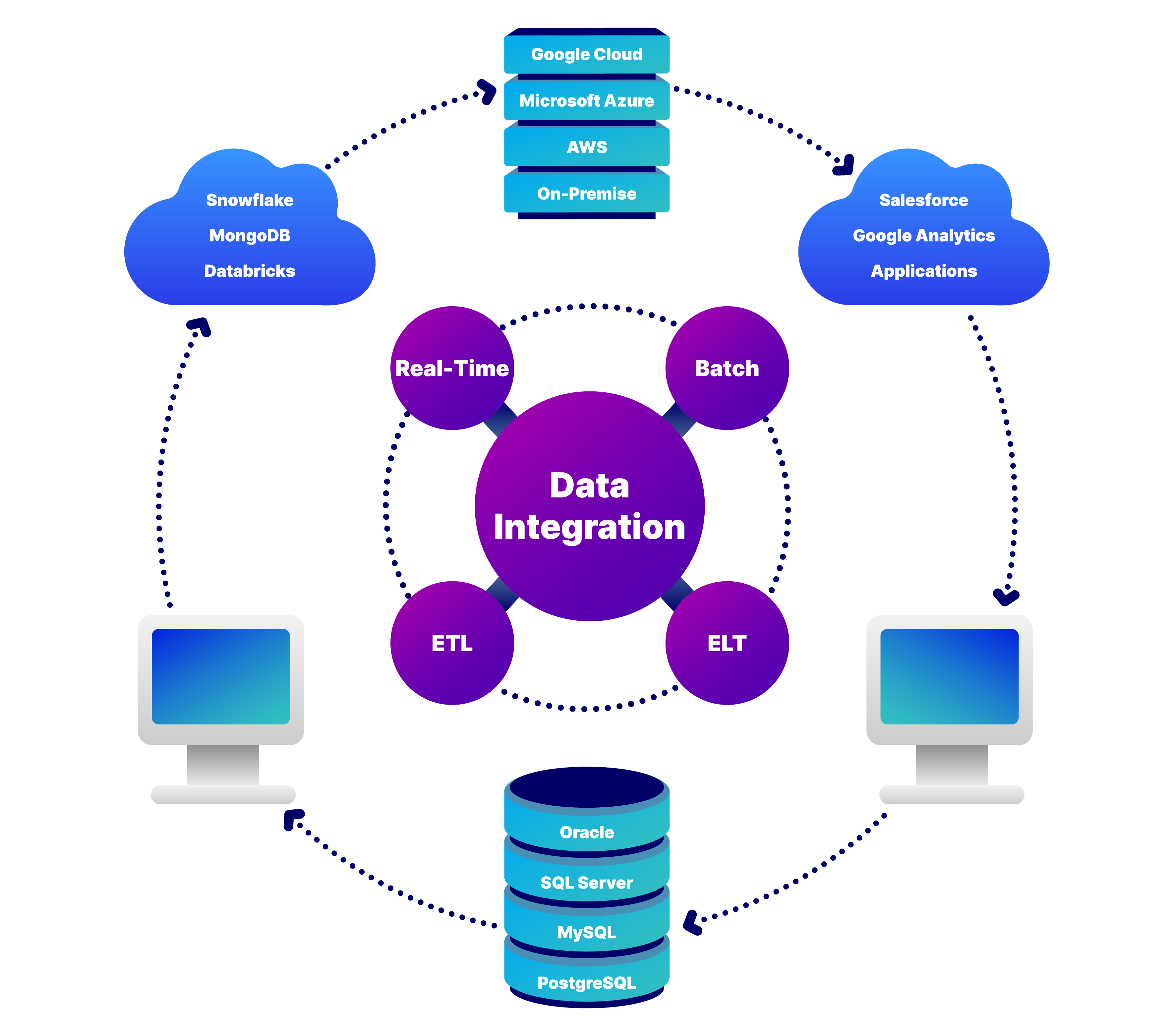Real-Time Integration: How to Exchange Data Instantaneously & Better Manage Expectations

With business moving faster than ever before, companies need to be able to quickly exchange and analyze data as soon as it is available. Historically though, data processing has largely been completed via EDI batch integration which is not performed instantaneously. Recently though, a newer, real-time approach to communicating with trading partners and customers has been quickly gaining momentum. This is referred to as real-time integration. And its strengthening relationships by enabling better expectations management than ever before.
If you are curious about what real-time data integration is, its benefits, and if it is right for your business needs, continue reading to find out.
- Batch Integration
- ETL vs. ELT Integration
- Real-Time Integration
- Benefits of Real-Time Integration
- Difference Between Batch & Real-Time Integration
- Real-Time vs. Near Real-Time Integration
- How to Start Exchanging Data in Real-Time
Types of Data Integration
Batch Integration
Batch integration and processing can be traced back to the 1980s and is the traditional, standard method for data integration. Batch processing is the collection of data that is gathered and stored. This data is then all processed together at a specified time, in a batch. Batch integration processing can be programmed to occur at specified times (i.e. every 12 hours) or when a certain threshold of data is collected.
Batch processing became popular because it was more efficient to process data in groups rather than individually. This is because legacy technologies (which were new at the time) are not as powerful as the modern solutions we have today. Additionally, batch integration resulted in fewer errors and increased network bandwidth since data processing was condensed.
ETL vs. ELT Integration
Extract-transform-load (ETL) and extract-load-transform (ELT) are two similar (albeit different) approaches to data integration. ETL is the more traditional approach of the two as it has been around since the 1970s.
ETL is an integration process used in data warehousing that provides a single source of truth for businesses by combining data from different sources. ETL integration has three distinct and sequential steps; extract, transform, and load.

1. Extract: Retrieves raw data from an unstructured data pool and migrates it into a temporary, staging data repository.
2. Transform: Structures and converts the data to match the correct target source.
3. Load: Loads the structured data into a data warehouse so it can be properly analyzed and used.
Each ETL stage requires interference from data engineers and developers to deal with the capacity limitations of traditional data warehouses.
On the other hand, ELT is a much more recent development and flips the sequencing of the second and third steps:

1. Extract: Raw data is accessed from a structured, semi-structured, or unstructured source.
2. Load: The data in its original source state, is loaded into a data lake for downstream analytics or provisioning.
3. Transform: Data is provisioned and transformed to meet the target requirements of an enterprise data warehouse or analytics application. However, the raw data is preserved in the data lake.
Instead of data transformation taking place before the data is actually written, ELT allows any required transformation to take place after loading into the target system. One advantage of this method is the preservation of data in its raw or source state. In particular, companies that are exploring big data require continual access to data in its original state over data quality that has been manipulated to fit a specific database.
Real-Time Integration
When it comes to data integration, one of the latest and most promising methods is real-time data integration. This means users can access data almost instantaneously. This data is updated across all integrated/connected applications, systems, and platforms within a company's digital ecosystem. This data is then presented from one, centralized location where users can easily access the information they need to see, based on their respective roles in the company.
To achieve real-time data integration, companies frequently utilize application programming interfaces (APIs). APIs are essentially interfaces that allow one application to communicate with another and share data via commands designed by programmers. Therefore, businesses can use APIs to show the data and functionality of their applications to third-party developers, business partners, and departments within their organization.
What Are the Benefits of Real-Time Integration?
Real-time integration provides businesses with many benefits, including:
1. More Relevant and Accurate Data
Since real-time integration allows information in a digital ecosystem to be updated with fresh data almost instantaneously, users are always shown the most accurate and up-to-date information available. This prevents users from analyzing, using, and referencing irrelevant data, and instead they can confidently draw conclusions using the best data available.
2. Greater Visibility and Agility
With real-time data integration, businesses have more visibility into their operations. With greater visibility, companies can increase agility and respond to incoming information faster, allowing for greater business continuity, stronger relationships with trading partners, increased profits, end-to-end visibility, and scalability.
3. Process Optimization
With access to more relevant and accurate information, as well as greater visibility in processes, businesses can analyze real-time data to influence better decision-making, create strategies, and optimize processes. Companies can dig into different areas of their supply chains to determine areas of weakness that can be improved, along with identifying high-performing areas. Process optimization includes minimizing errors and disruptions while simultaneously improving efficiencies.
4. Quicker and Better Communication
Customer service often improves with the addition of APIs and real-time data integration since communication happens in real-time without delays—instead of waiting for a human to respond to a message, or relying on batch integration. This makes response times quicker, processing times more efficient, and minimizes delays, errors, and supply chain disruptions.
5. Prompt and Continuous Updates
Lastly, API and real-time integration allow vital updates to be sent to various integrated parties. For example, 3PLs and logistic companies that use API integration can send real-time updates to customers and manufacturers about estimated delivery times and shipment locations, while manufacturers can send real-time notifications to customers when a certain product is back in stock.
6. Better Expectations Management
Given all the above, the net result is that companies employing real-time integration have a leg up over companies that do not, especially when it comes to strengthening their business relationships with key customers, suppliers, trading partners, or logistics organizations. Being able to see data faster, analyze situations in real-time, and resolve any problems quickly, doubtless results in greater mutual appreciation among the players in any given ecosystem.

What Is the Difference Between Batch Integration and Real-Time Integration?
The main difference between batch and real-time integration is how long it takes data to become available to users. With batch processing, data is collected and stored until either a certain threshold of data is collected, or until the platform is programmed to process the data (usually on a scheduled cadence such as every 12 hours). Once it is time for the data to be processed, all data is processed together at the same time, hence the name "batch processing". Therefore, with batch integration users tend to receive data on a delay.
On the other hand, with real-time integration, data is processed and becomes available to users right away. Whenever a new piece of data is ready for processing, it is individually processed immediately. This means users can always expect access to the most relevant and up-to-date information possible.
Which Is Better, Batch Processing or Real-Time Processing?
When deciding which is better, batch or real-time processing, it largely depends on the unique needs of each company. However, oftentimes the best approach is to incorporate both types of processing into a business's operations. This is because each approach offers value in different ways.
Real-time processing has the upper hand when it comes to the amount of time it takes to receive data since it processes information practically instantaneously. This makes it extremely beneficial for gaining accurate data, increasing visibility and agility, communicating faster with trading partners, optimizing processes, and influencing strategic decision-making.

Real-time integration and processing is also very helpful to receive and send real-time updates to customers and trading partners. For example, this can be done by integrating a manufacturer's digital ecosystem with supply chain visibility platforms like Project44 and FourKites. This enables updates to be sent to customers, such as an order's expected delivery date and time.
On the other hand, batch integration and processing has its own set of benefits. Notably, batch processing is particularly useful when processing a large volume of orders. For example, a big eCommerce marketplace receives 10,000 orders daily. If it attempts to process each order individually as soon as they are placed by customers, its system will likely experience delays, errors, system downtime, and network latency due to processing too many orders concurrently.
However, if the eCommerce marketplace utilizes batch processing and programs the orders to be processed as a group every 2 hours, the orders will be processed in a queue, one after the other, reducing network congestion and requiring fewer resources.
Therefore, it is important to consider your company's specific needs before deciding which approach to utilize. It may also be helpful to consider implementing both approaches into your digital ecosystem, as the two different approaches tend to work best when operating in tandem since they each offer a unique set of benefits.
Business is demanding more real-time continuous intelligence for better situation awareness and faster, more precise and nuanced decisions. - Gartner
What Is the Difference Between Real-Time and Near Real-Time Integration?
There is no rule specifying real-time integration has to take place in a certain amount of time or else it is not considered real-time anymore. However, it is commonly agreed upon that real-time data integration collects and processes data in a matter of seconds, while near real-time integration can take place over minutes or hours. For example, real-time processing is helpful for data streaming and radar systems, while near-time processing is good for sensor data and monitoring IT systems.
Deciding if real-time or near-real-time integration is best for a business mainly depends on how quickly data is needed. If a business needs information ASAP, real-time is the best option. However, if the data can be delayed by a few minutes or hours, near real-time integration will be sufficient.
How To Start Exchanging Data in Real-Time
To get started with real-time data integration, consider Cleo Integration Cloud (CIC). CIC is one of the leading real-time integration solutions on the market, providing customers with the API support they need to start processing and accessing data in real time. Benefits of CIC's API integration capabilities include:
Logistics and 3PLs
● End-to-end visibility and tracking
● Delivery management
● Cost-effective freight management
● Shipping cost calculation
Manufacturers
● Warehouse management
● Inventory visibility
● Inbound order validation
● SLA management and visibility
● eCommerce and marketplace Integration
Wholesalers
● Real-time information exchange
● Rapid trading partner onboarding
● Inventory management
● End-to-end visibility (integrate with Project44 and FourKites for real-time updates)
Furthermore, CIC enables MFT batch processing and just-in-time (JIT) integrations. As we discussed prior, real-time integration and batch processing work best when working in tandem since they both offer unique advantages.
Thus, CIC is an all-encompassing solution that enables our customers to reap the convenience and expedience of real-time data integration, as well as the reliability of batch processing. In addition, CIC supports EDI, AS2, and eCommerce integrations as well.

Cleo also offers various service offerings, including self-service, managed services, and blended services (a customizable approach that incorporates both self-service and managed services), so your business can choose the approach that best aligns with your needs.
So whether you're logistics, manufacturing, distribution & wholesale; or an alternate industry where quick internal and external integrations are a necessity, Cleo specializes in unifying complex partner ecosystems through robust integration capabilities. Creating a seamless integrated digital ecosystem of control, with clear expectations management, accurate and timely transactions, and strengthened business relationships.
If you have questions about what was covered in this blog, real-time integration, or Cleo's products and services, contact us at sales@cleo.com or +1.815.282.7695. Lastly, explore some of our educational resources through our resource library.

About Cleo

Watch a Demo

Comprehensive Guide to Gaining B2B Control

Duraflame Case Study
